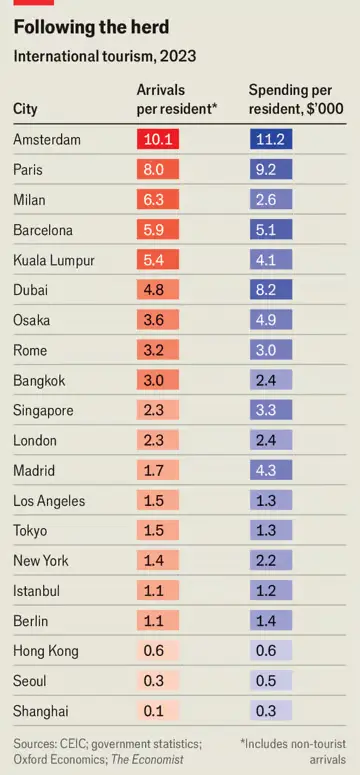Which Cities Have The Worst Overtourism Problem?
Tourism is often considered to be the backbone of economic well-being, giving jobs, an exchange of culture, and recognition of cities worldwide. But when does too much of a good thing become too much? Different cities around the world are now facing overtourism as one of the most prominent challenges. Tourists means income, but they bring much hassle with their expenses; they burden infrastructure, create an inconvenience to local life, and, to some extent, irk the locals. An analysis from The Economist tells which cities are now finding the delicate balance of revenue generation while trying to resolve the problem.

The Numbers Behind the Crowds
Understanding overtourism requires looking at both visitor numbers and visitor impact per member of the population. London and Tokyo are both substantial international travel magnets, each welcoming 20 million visitors per year. Istanbul isn't much farther behind, with 17 million tourists visiting its historic sites and bazaars. However, these numbers tell only half the story. When converted to a ratio per capita, the smaller cities of Amsterdam, Paris, and Milan reveal themselves as critical hotspots, with ratios of ten, eight, and six tourists per resident respectively.
Amsterdam: the epitome of open confrontation with overtourism. All put in place to curb this nuisance have been in vain. The cronies who run this commercialized city ever so unfriendly to living citizens and culture are still making a pretty penny from heavy tourists. The picturesque canals, majestic architecture, and scrumptious food ensure that many tourists continue to visit, creating tension between nurturing local culture and pandering to global demand.
Dollars and Disruption
Tourists do not merely bring numbers to specific places; they also provide billions to local economies. Dubai was the biggest in total tourist spending, with tourist dollars amounting to $29 billion last year alone. London and Singapore closely followed suit, recording $21 billion and $19 billion in expenditures, respectively. On a per-resident basis, however, Amsterdam, Paris, and Dubai dominate, showcasing how concentrated tourism can drive significant financial gains.
The downside, however, is that heightened tourist concentration is often associated with higher spending. This situation provides further stress on the already burdened cities in terms of congestion, pollution, and hypertrophic living conditions for localities. Between Amsterdam and Milan, tourists here spend four times more per resident than those in Milan, which shows this difference in benefits shared against the social costs incurred. Cutting back on tourists could help ease some strain on infrastructure-and definitely with cutting off potential income-at least an important trade-off for the tourists to smoothen.
Finding Balance: Lessons from Osaka and Madrid
It is not always that popular tourist destinations suffer from the deadly effects of overtourism. Some cities have somehow maintained a charm where they can host visitors with a sense of serenity for their residents. For instance, in Osaka, the second-largest metropolitan area in Japan, foreign tourists spend approximately $4,900 on each local while maintaining tourist density at a moderate level of four visitors for every local. Madrid likewise allows for an expenditure of $4,300 per resident with only two tourists per resident.
This would suggest that very high levels of revenue could be generated without imposing too much on the locals, but this is not guaranteed. There are signs of dissent even from relatively well-managed cities. Whereas in Osaka the authorities are now pondering putting an entrance fee upon the neck of foreign tourists to counteract the effect of overtourism, anti-tourist graffiti emerges in Madrid streets as the tension rises among residents.
Toward Sustainable Tourism
In the end, the overtourism discussion is merely the search for the optimum balance of just enough tourists to sustain local businesses and enrich communities, but not so great a number that daily life becomes unbearable for residents. This elusive balance, of course, may differ, dependent on the size of the city, infrastructural capabilities, and the tolerance of the people.
For now, Amsterdam and the likes are just a case study of caution against unrestricted tourism. Osaka and Madrid, on the other hand, still hold some hope as models for sustainable practice but are already under great pressure as global travel springs back post-COVID.
What this clearly demonstrates is that a clever mix of creativity and compromise will go a long way to solving overtourism, requiring fresh moves from the authority, businesses, and citizens. After all, no city wants to lose its character and livability for ephemeral economic gain.





